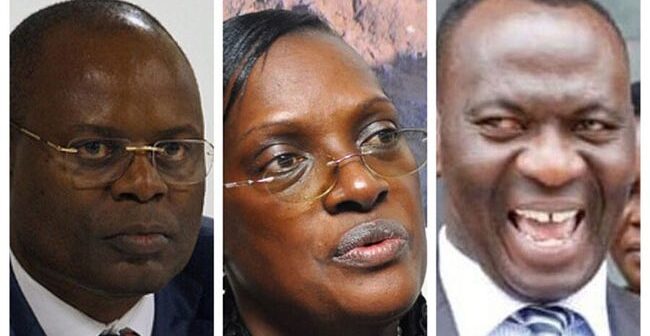3 revered judges of the Court of Appeal in London are astonished that a group of dubious, corrupt and deceitful officials from the Bank of Uganda who designed a plan to steal and sell off Crane Bank Limited (CBL) are not in prison.
And one of the recommendations highlighted in the Wednesday judgment by the Court of Appeal from the High Court of Justice Business and Property Courts in London was that in 2016 senior Ugandan government officials and officials of the Bank of Uganda (“the BoU”) engaged in a corrupt scheme to take control of CBL, making improper use of statutory and regulatory powers to do so, and then to sell its assets for the benefit of the parties to the scheme.
London Court of Appeal relays the events that took place between 2016 and 2017 when the unscrupulous BoU officials took over CBL and sold it to DFCU.
And that DFCU joined the corrupt scheme as the purchaser of CBL’s assets from the BoU (acting as a receiver of CBL), that purchase being at a gross undervalue. DFCU Bank’s holding company and certain current and former executives and directors of DFCU Bank are also alleged to have joined the scheme.’
This initially involved a Chinese diplomat, Dr Patrick Ho, who sought preferential access for CEFC China Energy (“CEFC”) in Uganda by bribing various government officials, including the Foreign Minister and the Deputy Governor of the BoU, in respect of which Dr Ho was subsequently convicted by the US District Court, Southern District of New York, a conviction upheld on appeal in 2020.
Dr Ho identified to the Foreign Minister that the acquisition of a local bank in Uganda was CEFC’s top priority. In or about June or July 2016 CBL was identified as the target.
Pursuant to the corrupt scheme, and notwithstanding its previous approval of CBL’s audited accounts, on 1 July 2016 the BoU adjusted CBL’s capital position by about US$76.5m and ordered CBL to raise additional capital of about US$46.4m by 31 July 2016.
Further, the BoU withdrew CBL’s authorisation to conduct most financial business and placed a lien over about US$50m of Treasury Bills held by CBL, seriously inhibiting CBL’s ability to raise the additional capital. In August 2016 the BoU ordered CBL to raise further capital in the sum of about US$26m.
On 18 September 2016, the Governor of the BoU issued a press statement falsely blaming CBL’s problems on weak loan performance and depositor flight. This triggered a run on CBL.
Between July and September 2016, CBL’s shareholders raised about US$8.2m to recapitalise CBL, but the BoU refused to allow that sum to be injected and required that it be held on deposit at the BoU. The BoU also took steps to thwart investment in CBL by independent financial institutions.
On 13 October 2016 the Deputy Governor of the BoU, through the Foreign Minister’s wife, privately informed Dr Ho of the possible acquisition of CBL. At their request the next day CEFC sent an email to the Deputy Governor’s private email expressing such interest.
On 16 October 2016, CBL requested emergency liquidity assistance from the BoU in the sum of US$115m, offering prime real estate held by a company owned by the second appellant, worth more than US$115m, as collateral. The BoU refused the request, offering only US$22.8m on terms which were impossible for CBL to meet.
On 20 October 2016, the BoU placed CBL into statutory management under provisions of the FIA.
Between 21 October 2016 and 9 January 2017 the BoU purported to inject about US$135m into CBL by way of liquidity support, for which CBL is purportedly liable, but the use of about US$79.5m of that sum is unaccounted for by the BoU.
CEFC’s interest in acquiring CBL ceased in late October 2016. In November 2016 at the latest, the BoU privately approached DFCU Bank with a proposal to acquire CBL as a going concern, but the transaction then transformed into an acquisition of CBL’s assets, subject to its liabilities.
On 9 December 2016, the BoU sent invitations to 13 parties to bid for CBL’s assets and liabilities but had given DFCU Bank preferential terms and early access to information. DFCU’s bid, despite being non-compliant and contemplating a breach of the FIA, was accepted by the BoU on 23 December 2016.
On 24 January 2017, the BoU placed CBL into receivership under section 95(1)(b) of the FIA, with the BoU as a receiver.
On 25 January 2017, the BoU (in its capacity as receiver of CBL) and DFCU Bank executed a Purchase of Assets and Assumption of Liabilities Agreement (“the Agreement”) whereby the BoU sold CBL’s assets to DFCU Bank (other than specified excluded assets, comprising claims and tax credits) in consideration of DFCU Bank assuming CBL’s liabilities (other than specified excluded liabilities, which included sums due to the BoU under the liquidity facilities in excess of UGX 200bn (c. US$58m)).
Also on 25 January 2017, the BoU and DFCU Bank entered a facility agreement, permitting DFCU Bank to repay the UGX 200bn liability over a period of 30 months, but on an interest-free basis. DFCU Bank recognised that the interest-free arrangement as creating a liability of only UGX 149bn.
The BoU subsequently sought to recover interest on the UGX 200bn from the appellants. xvi) By a letter to DFCU Bank, also dated 25 January 2017 (“the Side Letter”), the BoU agreed (a) to give DFCU Bank 11 months to bring itself into compliance with FIA capital adequacy and prudential requirements (b) that DFCU Bank’s non-performing loan and advances would be managed off-balance sheet for at least 12 months and (c) that fully provisional loans and advances acquired by DFCU Bank would not be part of its loan portfolio for reporting purposes until rehabilitated. The effect of the Side Letter was to reduce substantially the amount of additional capital required to be injected into DFCU Bank as a result of the acquisition of CBL’s assets and liabilities.
Due to the terms of the Agreement and the Side Letter, DFCU Bank acquired assets of CBL with a value far exceeding the liabilities DFCU Bank assumed and the costs it incurred. DFCU Bank (or its group) recorded in its annual report for 2017 that it had made an immediate windfall gain of about US$33.4m.
A portfolio of loans valued at UGX 100bn (about US$27.5m) was not reflected in the Agreement nor shown in any accounts. The appellants allege that that sum was transferred to the BoU and/or its officers secretly as a quid pro quo (or part of it) for the sale of CBL’s assets and to DFCU Bank at an undervalue.
Credit: Trumpet News



